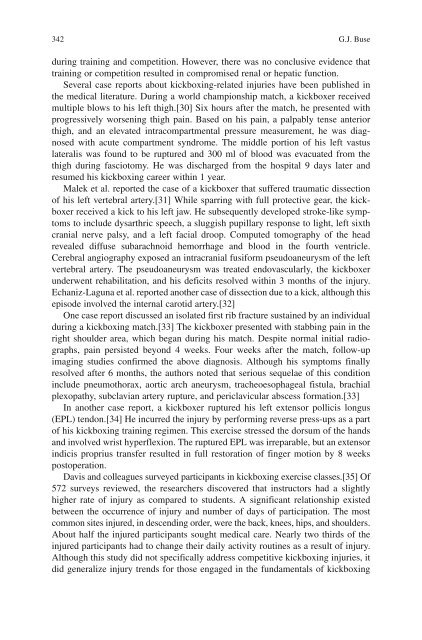Nutrition in Combat Sports
Nutrition in Combat Sports
Nutrition in Combat Sports
Create successful ePaper yourself
Turn your PDF publications into a flip-book with our unique Google optimized e-Paper software.
342 G.J. Buse<br />
dur<strong>in</strong>g tra<strong>in</strong><strong>in</strong>g and competition. However, there was no conclusive evidence that<br />
tra<strong>in</strong><strong>in</strong>g or competition resulted <strong>in</strong> compromised renal or hepatic function.<br />
Several case reports about kickbox<strong>in</strong>g-related <strong>in</strong>juries have been published <strong>in</strong><br />
the medical literature. Dur<strong>in</strong>g a world championship match, a kickboxer received<br />
multiple blows to his left thigh. [30] Six hours after the match, he presented with<br />
progressively worsen<strong>in</strong>g thigh pa<strong>in</strong>. Based on his pa<strong>in</strong>, a palpably tense anterior<br />
thigh, and an elevated <strong>in</strong>tracompartmental pressure measurement, he was diagnosed<br />
with acute compartment syndrome. The middle portion of his left vastus<br />
lateralis was found to be ruptured and 300 ml of blood was evacuated from the<br />
thigh dur<strong>in</strong>g fasciotomy. He was discharged from the hospital 9 days later and<br />
resumed his kickbox<strong>in</strong>g career with<strong>in</strong> 1 year.<br />
Malek et al. reported the case of a kickboxer that suffered traumatic dissection<br />
of his left vertebral artery. [31] While sparr<strong>in</strong>g with full protective gear, the kickboxer<br />
received a kick to his left jaw. He subsequently developed stroke-like symptoms<br />
to <strong>in</strong>clude dysarthric speech, a sluggish pupillary response to light, left sixth<br />
cranial nerve palsy, and a left facial droop. Computed tomography of the head<br />
revealed diffuse subarachnoid hemorrhage and blood <strong>in</strong> the fourth ventricle.<br />
Cerebral angiography exposed an <strong>in</strong>tracranial fusiform pseudoaneurysm of the left<br />
vertebral artery. The pseudoaneurysm was treated endovascularly, the kickboxer<br />
underwent rehabilitation, and his deficits resolved with<strong>in</strong> 3 months of the <strong>in</strong>jury.<br />
Echaniz-Laguna et al. reported another case of dissection due to a kick, although this<br />
episode <strong>in</strong>volved the <strong>in</strong>ternal carotid artery. [32]<br />
One case report discussed an isolated first rib fracture susta<strong>in</strong>ed by an <strong>in</strong>dividual<br />
dur<strong>in</strong>g a kickbox<strong>in</strong>g match. [33] The kickboxer presented with stabb<strong>in</strong>g pa<strong>in</strong> <strong>in</strong> the<br />
right shoulder area, which began dur<strong>in</strong>g his match. Despite normal <strong>in</strong>itial radiographs,<br />
pa<strong>in</strong> persisted beyond 4 weeks. Four weeks after the match, follow-up<br />
imag<strong>in</strong>g studies confirmed the above diagnosis. Although his symptoms f<strong>in</strong>ally<br />
resolved after 6 months, the authors noted that serious sequelae of this condition<br />
<strong>in</strong>clude pneumothorax, aortic arch aneurysm, tracheoesophageal fistula, brachial<br />
plexopathy, subclavian artery rupture, and periclavicular abscess formation. [33]<br />
In another case report, a kickboxer ruptured his left extensor pollicis longus<br />
(EPL) tendon. [34] He <strong>in</strong>curred the <strong>in</strong>jury by perform<strong>in</strong>g reverse press-ups as a part<br />
of his kickbox<strong>in</strong>g tra<strong>in</strong><strong>in</strong>g regimen. This exercise stressed the dorsum of the hands<br />
and <strong>in</strong>volved wrist hyperflexion. The ruptured EPL was irreparable, but an extensor<br />
<strong>in</strong>dicis proprius transfer resulted <strong>in</strong> full restoration of f<strong>in</strong>ger motion by 8 weeks<br />
postoperation.<br />
Davis and colleagues surveyed participants <strong>in</strong> kickbox<strong>in</strong>g exercise classes. [35] Of<br />
572 surveys reviewed, the researchers discovered that <strong>in</strong>structors had a slightly<br />
higher rate of <strong>in</strong>jury as compared to students. A significant relationship existed<br />
between the occurrence of <strong>in</strong>jury and number of days of participation. The most<br />
common sites <strong>in</strong>jured, <strong>in</strong> descend<strong>in</strong>g order, were the back, knees, hips, and shoulders.<br />
About half the <strong>in</strong>jured participants sought medical care. Nearly two thirds of the<br />
<strong>in</strong>jured participants had to change their daily activity rout<strong>in</strong>es as a result of <strong>in</strong>jury.<br />
Although this study did not specifically address competitive kickbox<strong>in</strong>g <strong>in</strong>juries, it<br />
did generalize <strong>in</strong>jury trends for those engaged <strong>in</strong> the fundamentals of kickbox<strong>in</strong>g

















